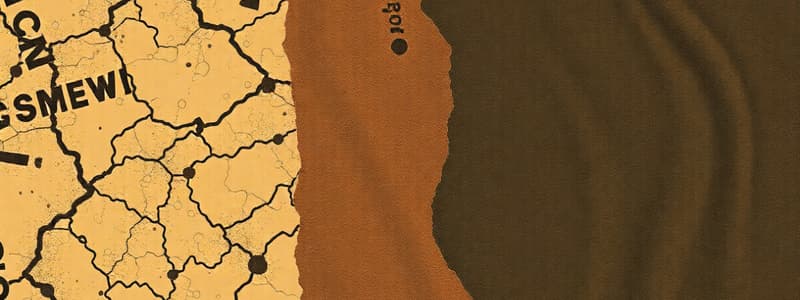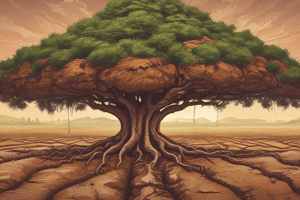Podcast
Questions and Answers
Which soil type is known for allowing water to flow through it easily?
Which soil type is known for allowing water to flow through it easily?
- Loam
- Clay
- Impermeable
- Permeable (correct)
Which soil particle, when present in large amounts, results in soil that holds water tightly?
Which soil particle, when present in large amounts, results in soil that holds water tightly?
- Sand
- Loam
- Silt
- Clay (correct)
What term describes a soil containing a mixture of grain sizes?
What term describes a soil containing a mixture of grain sizes?
- Loam (correct)
- Silt
- Sand
- Clay
What is the top layer of soil called?
What is the top layer of soil called?
Which soil layer is known for accumulating soluble minerals and clays?
Which soil layer is known for accumulating soluble minerals and clays?
In soil science, what name is given to a soil profile?
In soil science, what name is given to a soil profile?
Which soil type typically forms in grassland regions?
Which soil type typically forms in grassland regions?
A soil described as 'permeable' readily allows what to flow through it?
A soil described as 'permeable' readily allows what to flow through it?
What type of soil is known to form in rainforests?
What type of soil is known to form in rainforests?
Which of the following is a characteristic of topsoil?
Which of the following is a characteristic of topsoil?
What is the primary process that leads to the fracturing of bedrock?
What is the primary process that leads to the fracturing of bedrock?
What causes chemical weathering in soil?
What causes chemical weathering in soil?
Which horizon is the most biologically active?
Which horizon is the most biologically active?
What minerals are pedalfers rich in?
What minerals are pedalfers rich in?
What climate promotes the formation of pedalfer soils?
What climate promotes the formation of pedalfer soils?
What layer is pedocal named for?
What layer is pedocal named for?
Which of the following describes laterite soils?
Which of the following describes laterite soils?
What is the main characteristic of sandy soils?
What is the main characteristic of sandy soils?
How long might it take for a good fertile topsoil to form under ideal conditions?
How long might it take for a good fertile topsoil to form under ideal conditions?
What kind of weathering is caused by plants such as lichens?
What kind of weathering is caused by plants such as lichens?
Flashcards
Permeable Soil
Permeable Soil
Soil that allows water to flow easily through it due to large, well-connected spaces between inorganic particles.
Water-Holding Soils
Water-Holding Soils
Soils with very small spaces that excel at retaining water.
Loam
Loam
A soil comprised of a mixture of different-sized soil grains.
Soil Horizons
Soil Horizons
Signup and view all the flashcards
Soil Profile
Soil Profile
Signup and view all the flashcards
Topsoil
Topsoil
Signup and view all the flashcards
Subsoil
Subsoil
Signup and view all the flashcards
C Horizon
C Horizon
Signup and view all the flashcards
Pedalfer
Pedalfer
Signup and view all the flashcards
Pedocal
Pedocal
Signup and view all the flashcards
Laterite
Laterite
Signup and view all the flashcards
Study Notes
Soil Texture and Composition
- The inorganic portion of soil consists of different-sized particles in varying proportions.
- Soil properties are determined by the combination of particle sizes and their proportions.
- Permeable soil allows water to flow through easily because of large, well-connected spaces between inorganic particles.
- Sandy or silty soils are permeable, water-draining 'light' soils because of their spaces.
- Soils with small spaces retain water.
- Clay-rich soils are heavier, hold together more tightly, and retain water.
- Loam is a soil containing a mixture of grain sizes.
- Soil scientists measure percentages of sand, silt, and clay to determine soil type precisely.
- Soil type is determined by plotting the percentages of sand, silt, and clay on a triangular diagram.
- Clay is at the top of the triangular diagram.
- Sand is at the left corner of the triangular diagram.
- Silt is at the right corner of the triangular diagram.
- Loams have less than 50% clay and are in the lower middle of the triangular diagram.
Soil Horizons and Profiles
- Residual soil forms over years via mechanical and chemical weathering of solid rock.
- Bedrock fractures through weathering from ice wedging or other physical processes.
- Water, oxygen, and carbon dioxide seep into cracks, causing chemical weathering.
- Plants like lichens or grasses establish and contribute to biological weathering.
- Weathered material accumulates until soil forms.
- Soil horizons develop as each layer undergoes progressive alteration, with the most alteration in the top layer.
- Each successive lower layer is altered gradually less due to reduced water and air contact.
- Soil horizons are the different layers of soil visible on a hillside.
- Soil profile refers to all the soil horizons put together.
- Simplest soils are composed of topsoil (A horizon), subsoil (B horizon), and C horizon.
- Soil horizons are distinctly visible.
Topsoil (A Horizon)
- The A horizon is commonly refered to as topsoil.
- Topsoil is usually the darkest layer due to highest organic material proportion.
- Topsoil is the region of intense biological activity, including insects, worms, and roots.
- Plant roots help hold topsoil in place.
- Minerals in topsoil dissolve in water and transfer to lower layers.
- Small particles like clay can be carried to lower layers by seeping water.
Subsoil (B Horizon)
- The B horizon is commonly referred to as subsoil.
- Subsoil is where soluble minerals and clays accumulate.
- Subsoil is lighter brown, retains more water than topsoil because of iron and clay minerals.
- Subsoil has less organic material than topsoil.
C Horizon
- The C horizon is a layer of partially altered bedrock.
- The C horizon contains evidence of weathering and pieces of original rock that can be identified.
- The amount of soil horizons varies by climate region.
- The amount of soil horizons varies by region.
- Some areas develop five or six distinct layers.
- Some areas develop thin soils or absent soils.
Types of Soils
- Soil scientists recognize thousands of soil types, each with specific characteristics.
- Pedalfer, pedocal, and laterite are three basic soil types.
Pedalfer
- Pedalfer is a dark, fertile soil that forms in forested regions.
- Deciduous trees require at least 65 cm of rain per year.
- Pedalfers are common in the temperate, eastern part of the United States.
- The word pedalfer comes from aluminum (Al) and iron (Fe).
- Pedalfers are very fertile, dark brown or black soils.
- Pedalfers are rich in aluminum clays and iron oxides.
- Soluble minerals are carried away, leaving less soluble clays and iron oxides due to high rainfall.
Pedocal
- Pedocal is an alkaline soil that forms in grassland regions.
- Pedocal soils form in drier, temperate areas with grasslands and brush.
- Climates forming pedocals have less than 65 cm of rainfall annually.
- Pedocals experience less chemical weathering and have less water.
- Pedocals contains more soluble minerals and fewer clay minerals compared to pedalfers.
- Pedocal soils have lower amounts of organic material and are less fertile.
- Pedocal is named for the calcite-enriched layer called caliche.
- Caliche is where soluble minerals concentrate due to the evaporation of water.
Laterite
- Laterite is a thick, nutrient-poor soil found in rainforests.
- Laterite soils form in hot, wet, tropical regions with intense chemical weathering.
- Tropical rainforests contains laterite because it rains everyday.
- Little to no humus and all soluble minerals and plant nutrients are removed.
- Laterite is commonly composed of least soluble materials, such as aluminum and iron oxides.
- Laterite soils are often red from the iron oxides and bake hard like brick when exposed to the sun.
- Each climate produces a unique soil type.
- Thinner soils and soluble minerals forms where there is less weathering.
- Thick, nutrient-poor soils form where there is intense weathering.
- Soil development is a slow process typically taking hundreds or thousands of years for fertile topsoil to form.
- Soil can form at an estimated rate of about 1mm/year under the best conditions.
- Poor conditions may require thousands of years for soil formation.
Studying That Suits You
Use AI to generate personalized quizzes and flashcards to suit your learning preferences.



